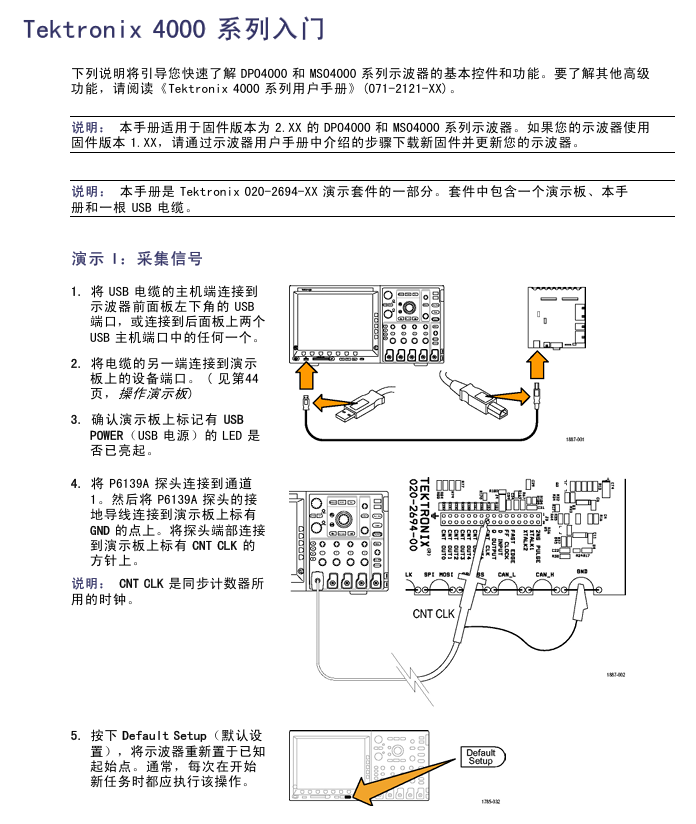Tektronix 4000 series oscilloscope
(3) Demo XI: Search Function
Step: ① Press "Search" ->"Search" on the lower bezel ->"Turn on" on the side bezel; ② Clear all tags; ③ Select "Pulse" for "Search Type", select 2 for "Source", and set "Positive" for "Polarity"; ④ The threshold is set to ≈ 2.00 V (midpoint of channel 2 waveform); ⑤ Select "Pulse width<8.00 ns" for "Set marking time" and adjust it to 5 μ s (display hollow triangle mark, event number displayed in the bottom left corner); ⑥ Arrow button navigation markers; ⑦ Zoom in and observe (e.g. 5kX zoom); ⑧ Close search (Search → Close).
3. Serial triggering and analysis
(1) Demo XII: Serial Triggering and Analysis (Using I2C as an Example)
Step: ① Adjust the scaling factor by 50X and pan to the target view; ② Press B1 → "Bus" and select "I2C"; ③ Define Input "(SCLK=Channel 1, SDA=Channel 2); ④ Set the midpoint of the waveform as the "threshold"; ⑤“Menu Off”; ⑥ Zoom observation (green bar=packet start, yellow box=address, cyan box=data, red box=lost confirmation, red bar=stop); ⑦ Switch between "binary/hexadecimal" for "bus display"; ⑧ Event Table "(displays packet timestamps when enabled, similar to a logic analyzer); ⑨ Trigger settings: "Trigger menu" → "Type" select "Bus" → "Signal source bus" select B1 → "Address" set to 50 (hexadecimal), "Direction" set to "Write" → "Single" acquisition → Zoom to view trigger content.
(2) Demo XIII: Searching for Serial Signals (Taking I2C as an Example)
Step: ① "Trigger menu" ->"Type", select "Edge" ->"Single time" collection; ② Select "Bus" for "Search" → "Search Type", choose B1 for "Source Bus"; ③ Select "Start" for "Search" → Arrow button navigation mark; ④ Select "Address" for "Search", set to 76 (hexadecimal) → decrease results; ⑤ Save all tags "(hollow to solid, old tags can be retained).
(3) Demo XIV: Monitoring and Decoding RS-232
Prerequisite: Install DPO4COMP application module;
Step: ① P6139A (Channel 1 → RS-232 TX, connected to GND); ② Press' Serial SELECT 'until the RS-232 LED lights up; ③ Default Setup "→" Auto Settings "→" Collection "→" Record Length "=1M points; ④ Set the horizontal "scale" to 20 ms/grid; ⑤ Press B1 → "Bus" and select "RS-232"; ⑥ Define Input "with channel 1 as" Send Input "and" Configure "with a bit rate of 9600; ⑦ Select "ASCII" ->"Single" ->Scale 10X (read characters) for "Bus Display"; ⑧ Play "scrolling messages; ⑨ Event Table "(displaying a list of characters).
(4) Demo XV: Serial Data Pattern Triggering (Using RS-232 as an Example)
Step: ① "Trigger Menu" → "Type" Select "Bus" → "Signal Source Bus" Select RS-232 B1; ② Trigger Open "and select" Send Data "; ③ Set "Data" to 51 (hexadecimal, corresponding to ASCII "Q"); ④ Menu Off "→" Single "; ⑤ Display the word 'Restart' (triggered successfully).

MSO4000 Function Demonstration
1. Core Features
(1) Usability
Wave Inspector supports digital channels (zoom/pan/search/mark);
P6516 digital probe (dual eight channel longitudinal slot, blue coaxial cable identification channel, can be self-made grounding wire);
Color coded display (green=high level, blue=low level, white edge=multiple transitions, gray blur=edge uncertainty).
(2) Performance
16 digital channels (added on the basis of DPO);
MagniVu function (10000 point sampling, 60.6ps timing resolution, 16.5 GS/s sampling rate, switchable main recording/MagniVu recording);
Threshold setting for each channel (supporting multiple logical series);
Supports 4 buses (serial/parallel);
Establish/maintain bus triggering (including 16 digital+4 analog channels, auxiliary input can be expanded to 20 channels);
Parallel bus triggering (user-defined logical mode);
10 M record length (all analog/digital channels);
35000 waveforms per second (analog channel, reducing dead time).
2. Specific demonstration
(1) Demo XVI: Setting up digital channels
Step: ① P6516 probe (D0-D6 → CNT OUT 0-6, D7 → CNT CLK, all grounded); ② Default Setup "→ Close channel 1; ③ Set the horizontal "scale" to 200 ns/grid; ④ Press the blue "D15-D0" button (display digital channel, green=high, blue=low); ⑤ Set "height" to "M" (medium); ⑥ Open D7-D0 "(or separately open D0-D7); ⑦ Select D7 from "Trigger Menu" → "Source" → "Menu Off"; ⑧ Channel grouping: Highlight the group marker (inverted triangle), rotate knob b to move the group waveform.
(2) Demo XVII: Threshold for each channel
Operation: Press the blue "D15-D0" button → follow the "Threshold" button below → use the multifunction knob a/b (group/individual setting of channel threshold voltage).
- EMERSON
- Honeywell
- CTI
- Rolls-Royce
- General Electric
- Woodward
- Yaskawa
- xYCOM
- Motorola
- Siemens
- Rockwell
- ABB
- B&R
- HIMA
- Construction site
- electricity
- Automobile market
- PLC
- DCS
- Motor drivers
- VSD
- Implications
- cement
- CO2
- CEM
- methane
- Artificial intelligence
- Titanic
- Solar energy
- Hydrogen fuel cell
- Hydrogen and fuel cells
- Hydrogen and oxygen fuel cells
- tyre
- Chemical fiber
- dynamo
- corpuscle
- Pulp and paper
- printing
- fossil
- FANUC
- Food and beverage
- Life science
- Sewage treatment
- Personal care
- electricity
- boats
- infrastructure
- Automobile industry
- metallurgy
- Nuclear power generation
- Geothermal power generation
- Water and wastewater
- Infrastructure construction
- Mine hazard
- steel
- papermaking
- Natural gas industry
- Infrastructure construction
- Power and energy
- Rubber and plastic
- Renewable energy
- pharmacy
- mining
- Plastic industry
- Schneider
- Kongsberg
- NI
- Wind energy
- International petroleum
- International new energy network
- gas
- WATLOW
- ProSoft
- SEW
- wind
- ADVANCED
- Reliance
- YOKOGAWA
- TRICONEX
- FOXBORO
- METSO
- MAN
- Advantest
- ADVANCED
- ALSTOM
- Control Wave
- AB
- AMAT
- STUDER
- KONGSBERG
- MOTOROLA
- DANAHER MOTION
- Bently
- Galil
- EATON
- MOLEX
- Triconex
- DEIF
- B&W
- ZYGO
- Aerotech
- DANFOSS
- KOLLMORGEN
- Beijer
- Endress+Hauser
- MOOG
- KB
- Moxa
- Rexroth
- YAMAHA
- Johnson
- Westinghouse
- WAGO
- TOSHIBA
- TEKTRONIX


Email:wang@kongjiangauto.com






















































































































